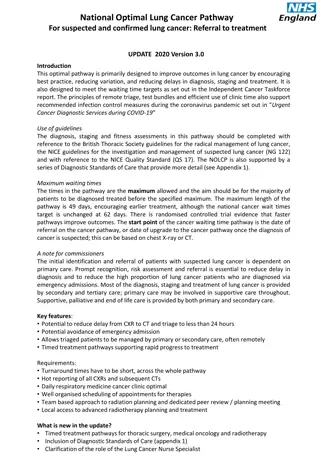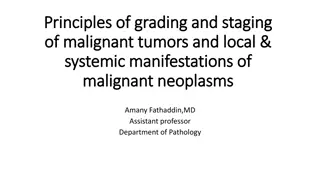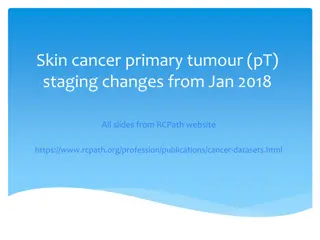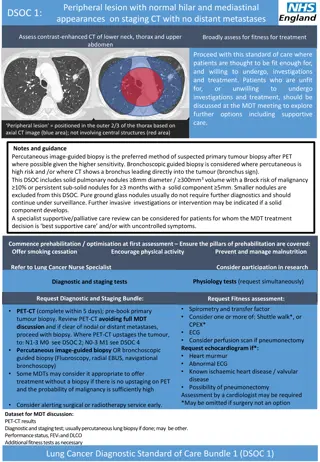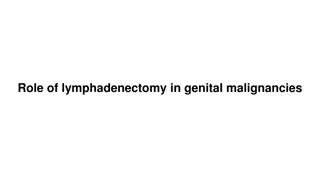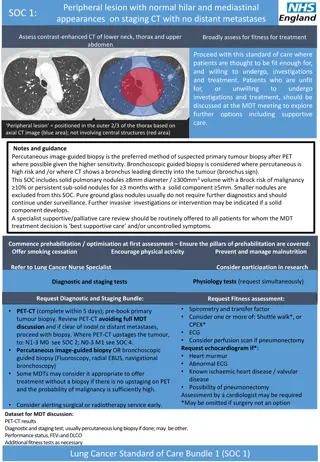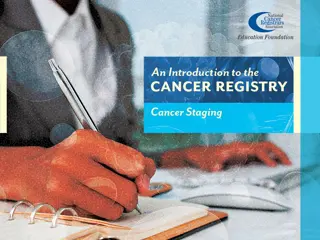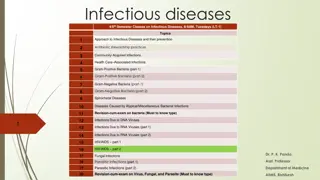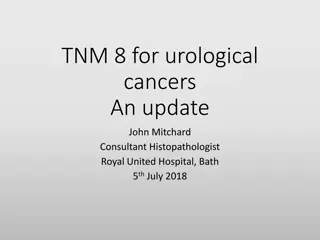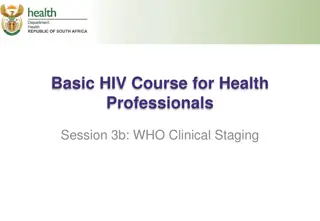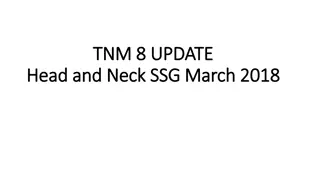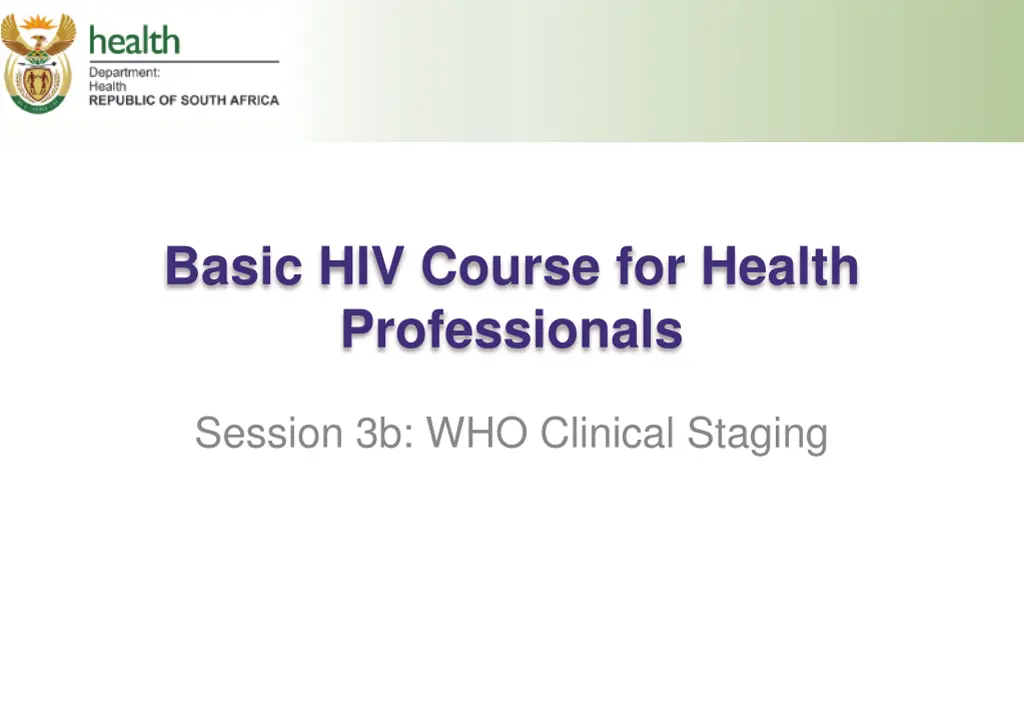
Understanding WHO Clinical Staging for HIV
Explore the WHO clinical staging system for HIV, essential for tracking and managing the disease effectively. Learn about the stages, symptoms, and when to investigate further, all crucial for healthcare professionals in South Africa.
Download Presentation

Please find below an Image/Link to download the presentation.
The content on the website is provided AS IS for your information and personal use only. It may not be sold, licensed, or shared on other websites without obtaining consent from the author. If you encounter any issues during the download, it is possible that the publisher has removed the file from their server.
You are allowed to download the files provided on this website for personal or commercial use, subject to the condition that they are used lawfully. All files are the property of their respective owners.
The content on the website is provided AS IS for your information and personal use only. It may not be sold, licensed, or shared on other websites without obtaining consent from the author.
E N D
Presentation Transcript
Basic HIV Course for Health Professionals Session 3b: WHO Clinical Staging
Learning Objectives By the end of this session participants should be able to: Describe the WHO staging system for HIV
Overview of WHO Clinical Staging (1) HIV infection is classified by a staging system for tracking and monitoring the HIV epidemic and for providing clinicians and patients with important information about HIV disease stage and clinical management South Africa uses the WHO staging system This Photo by Unknown Author is licensed under CC BY-NC-SA
Overview of WHO Clinical Staging (2) Four stages (1 4) using clinical criteria, once HIV infection confirmed WHO staging used to determine: Baseline evaluation Eligibility for Co-trimoxazole Disease progression Treatment failure in absence of or in addition to lab findings
Stage 1 Symptoms Asymptomatic Persistent generalised lymphadenopathy Painless enlarged lymph nodes >1 cm in two or more non-contiguous sites (excluding inguinal) in the of known cause and persisting for several years
When Should Enlarged Lymph Nodes Be Investigated Further? Investigate further if lymph node is: growing rapidly painful/tender large >2cm matted fluctuant there is unexplained weight loss Cervical lymphadenitis due to TB Depts.washington.edu
Stage 2 Symptoms Unexplained weight loss (<10% of presumed or measured weight) Herpes zoster Papular pruritic eruption Angular cheilitis Seborrhoeic dermatitis Recurrent upper respiratory tract infections Fungal nail infections Recurrent oral ulceration
Stage 2 - Herpes Zoster Caused by reactivation of the varicella zoster virus Common presenting condition in the early stages of HIV infection Causes a painful vesicular rash in a dermatomal distribution Starts with pain, then blisters develop which ulcerate Stage 2 if current or in last 2 years
Herpes Zoster - Dermatomal Distribution
Stage 2 - Herpes Zoster Generally limited to one dermatome With increased immunodeficiency can be: multi-dermatomal (usually contiguous) disseminated recurrent followed by post-herpetic neuralgia and scarring
Management Herpes Zoster Acyclovir (preferably within the first 72 hours) If secondary infection erythromycin Analgesia e.g. paracetamol codeine Prescribe soothing antibacterial cream e.g. silver sulfadiazine or povidine-iodine If pain not controlled prescribe amitriptyline at night o Can be used during the acute phase or after the lesions have healed Acyclovir 400mg
Management of Herpes Zoster When to refer: Refer if suspected eye involvement Hutchinson sign - vesicles on tip of or side of nose - indicates possible eye involvement
Stage 2 - Papular Pruritic Eruption Clinical features: Severe itch Papular lesions often on limbs and trunk Often with marked post-inflammatory pigmentation Management: Potent topical steroid ointment Treat secondary infection if present Sedating antihistamine at night e.g. promethazine e.g. promethazine Management: Potent topical steroid ointment Treat secondary infection if present Sedating antihistamine at night Handbook of HIV Medicine, 3rd Ed.
Stage 2 - Angular Cheilitis Splits or cracks at the angle of the mouth not due to iron or vitamin deficiency May be due to candida infection and respond to antifungal treatment topical nystatin cream or miconazole gel
Stage 2 - Seborrhoeic Dermatitis Itchy, scaly skin condition Particularly affects hairy areas - scalp, axillae, upper trunk and groin
Management of Seborrhoeic Dermatitis Management: Topical steroids Secondary infections flucloxacillin Scalp selenium sulphide, cetrimide or povidine-iodine shampoos If no response give a trial of an azole anti-fungal e.g. fluconazole topically or systemically Handbook of HIV Medicine, 3rd Ed.
Stage 2 - Recurrent Upper Respiratory Tract Infections Upper respiratory tract infections occur with increased frequency in HIV infection: Sinusitis - unilateral face pain with nasal discharge Otitis media - painful inflamed eardrum Tonsillopharyngitis without features of viral infection (such as coryza or cough) Current event plus one or more in last six-month period = stage Management: Analgesia Antipyretics Antibiotics
Stage 2 - Recurrent Oral Ulceration Aphthous ulcers - painful, well- circumscribed with a halo of inflammation and a yellow-grey pseudomembrane May be single or multiple Large lesions may be progressive and heal slowly Can occur anywhere in the mouth, oropharynx oesophagus 2 or more episodes in last 6 months = stage 2 www.childrensoralcare.ca
Management of recurrent Oral Ulceration Management: Topical steroids e.g.triamcinolone acetonide 0.1% in sodium carboxycellulose base (kenalog in Orobase) Mouth rinse e.g. 1% topical povidine-iodine or 0.2% chlorhexidine digluconate For large, persistent ulcers Beclomethasone spray 1-2 puffs twice daily onto ulcer Benzydamine mouthwash or Betamethasone tabs dissolve in water and use as mouthwash Ulcers not responding to treatment should be referred for biopsy to exclude malignancy, CMV Handbook of HIV Medicine, 3rd Ed.
Stage 3- Symptoms Chronic diarrhoea Persistent fever Persistent oral candidiasis Oral hairy leukoplakia Severe bacterial infections Gingival and periodontal lesions Haematological lesions
Stage 3 - Unexplained Severe Weight Loss Severe unexplained weight loss (>10% of presumed or measured body weight) Visible thinning of face, waist and extremities with obvious wasting or body mass index <18.5 kg/m2 In pregnancy, the weight loss may be masked If seeing a patient for the first time, how would you determine that they have lost weight?
Stage 3 Chronic Diarrhoea Unexplained chronic diarrhoea for >1month Loose or watery stools three or more times daily Reported for longer than one month 2 or more stool tests reveal no pathogens
Stage 3 Persistent Fever Unexplained persistent fever (intermittent or constant, for >1month) Fever or night sweats for more than one month May be intermittent or constant Lack of response to antibiotics or antimalarial agents No other obvious foci of disease reported or found on examination Malaria must be excluded in malaria areas
Stage 3 - Persistent Oral Candidiasis Pseudomembranous - creamy white curd- like plaques that can be scraped off, leaving an erythematous surface with or without bleeding Erythematous form - red patches on tongue, palate or lining of mouth, usually painful or tender
Stage 3 - Persistent Oral Candidiasis Hyperplastic diffuse, white, adherent lesions on buccal mucosa needs to be distinguished from oral hairy leukoplakia Angular cheilitis
Management of persistent Oral Candidiasis Nystatin oral suspension If no improvement or if severe: oMiconazole oral gel and oAmphotericin B lozenges If no response in 1-2 weeks systemic antifungals may be needed Clinical resource guide, Version 1.6, October 2013 Handbook of HIV Medicine, 3rdEd.
Stage 3 - Oral Hairy Leukoplakia Whitish-grey corrugated lesions Occur on lateral borders of the tongue May be unilateral or bilateral Cannot be removed Asymptomatic Does not require specific treatment May resolve with ART Clinical resource guide, Version 1.6, October 2013
Oral Hairy Leukoplakia How is Oral Hairy Leukoplakia Differentiated from Oral Candida? Oral hairy leukoplakia cannot be scraped off and does not bleed Oral candida can be scraped off with a spatula and may bleed
Stage 3- Symptoms Examples: Pneumonia Empyema Pyomyositis Bone or joint infection Meningitis Bacteraemia Severe pelvic inflammatory disease
Stage 3 - Bacterial Pneumonia Short history of about 3-7 days of: fever chills pleuritic chest pain cough sputum production shortness of breath Right upper lobe consolidation thebody.com
Stage 3 Pulmonary TB Pulmonary tuberculosis (current)
Management of Bacterial Pneumonia Uncomplicated, non-severe bacterial pneumonia: Amoxicillin or amoxicillin/clavulanic acid Slow or incomplete resolution despite treatment refer to the doctor Refer the following patients to hospital: Confusion Blood urea >7mmol/l Respiratory rate >30/min BP <90 systolic or <60 diastolic Give 1g Ceftriaxone IV stat at outpatient facility and refer
Stage 3 Gingival and Periodontal Lesions Acute necrotizing ulcerative gingivitis Destruction of interdental papillae with bleeding, ulceration, necrosis, sloughing Bone not involved Necrotizing ulcerative periodontitis Necrotic destruction of periodontium severe pain loosening of teeth bad odour destruction of bone
Management of Gingival and Periodontal Lesions Encourage oral health brushing and flossing Dental referral Debridement Topical antiseptics If severe, systemic antibiotics e.g. metronidazole Handbook of HIV Medicine, 3rd Ed.
Stage 3 Haematological Effects Unexplained anaemia (<8g/dl), and or neutropaenia (<0.5 x 109/L and or thrombocytopaenia (<50 x 109/L) for more than one month Not explained by other non-HIV conditions Not responding to standard therapy (haematinics, anthelmintic agents) Blood vessel White blood cell Red blood cell Platelet Plasma
Stage 4- Symptoms HIV wasting syndrome CNS toxoplasmosis Recurrent bacterial pneumonia Chronic Herpes Simplex Virus Infection or Visceral Infection Oesophageal Candidiasis Extrapulmonary TB Kaposi Sarcoma Chronic Isosporiasis and Chronic Cryptosporidiosis Pneumocystis Pneumonia HIV Encephalopathy Recurrent Non-Typhoid Salmonella Bacteraemia Disseminated Non-Tuberculous Mycobacteria Infection HIV-Associated Nephropathy Lymphoma Invasive cervical cancer Cytomegalovirus Symptomatic HIV-associated Cardiomyopathy Progressive Multifocal Leukoencephalopathy Disseminated mycosis (e.g. histoplamosis, coccidiomycosis) Atypical disseminated leishmaniasis
Stage 4 - HIV Wasting Syndrome Unexplained involuntary weight loss (>10% baseline body weight), with obvious wasting or body mass index <18.5 PLUS EITHER Unexplained chronic diarrhoea (loose or watery stools three or more times daily) reported >1 month OR reports of fever or night sweats for >1 month without other cause and lack of response to antibiotics
Management of HIV Wasting Syndrome Treat opportunistic infections if present Refer dietician Initiate ART
Stage 4 CNS Toxoplasmosis Rare if CD4 count >200 cells/mm3 or on CPT Clinical features: Focal neurological signs or Decreased level of consciousness Diagnosis: Toxoplasma serology IgG positive Multiple mass lesions on CT/ MRI Transmission of toxoplasmosis www.parasitesinhumans.org
Management of CNS Toxoplasmosis Cotrimoxazole Relapse is common o Continue secondary cotrimoxazole prophylaxis thereafter Handbook of HIV Medicine, 3rd Ed.
Stage 4 - Recurrent Bacterial Pneumonia Current episode plus one or more previous episodes in the past six months
Stage 4 - Chronic Herpes Simplex Virus Infection or Visceral Infection Herpes simplex lesions begin with grouped vesicles on an inflamed base, followed by erosions, crusting and healing In the early stages of HIV, this classical picture is followed, with healing in 1- 2 weeks without treatment Classical picture - Grouped vesicles on an inflamed base
Stage 4 - Chronic Herpes Simplex Virus Infection or Visceral Infection Chronic herpes simplex lesions
Management of Chronic Herpes Simplex Virus Infection or Visceral Infection Condom use and partner notification Apply antibacterial cream Oral acyclovir Paracetamol as needed for pain If severe, refractory or disseminated IV acyclovir may be required Clinical resource guide, Version 1.6, October 2013
Stage 4 Oesophageal Candidiasis Occurs in severe immune deficiency (CD4 <100) Clinical features: Oral thrush is present in many patients Difficulty swallowing (dysphagia) Pain on swallowing (odynophagia) Burning central chest pain associated with eating Oesophageal candidiasis seen at gastroscopy Standard Treatment Guidelines and Essential Medicines List, 2012 Clinical resource guide, Version 1.6, October 2013
Management of Oesophageal Candidiasis Ensure adequate hydration Oral fluconazole (IV if patient unable to swallow)
Stage 4 - Extrapulmonary TB TB that occurs in any site other than the lungs Common types include: TB lymphadenitis Abdominal TB TB meningitis Pleural TB Spinal TB TB pericarditis Most cases respond to 6 months of standardised TB treatment, but longer courses may be required in cases of severe disease TB lymphadenitis www.japi.org
Stage 4 Kaposi Sarcoma Clinical features: May involve skin, oral cavity, lymph nodes, viscera (particularly lungs, intestine) Lesions initially papular, later becoming nodules and plaques Dark brown to violet in colour, often multiple lesions Lymphoedema is a common complication
Diagnosis of Kaposi Sarcoma Most are diagnosed based on typical macroscopic appearance Biopsy needed for atypical lesions or if chemotherapy considered
Stage 4 Kaposi Sarcoma Management: Limited mucocutaneous KS often resolves or substantially regresses on ART Referral: Radiotherapy or intralesional chemotherapy for symptomatic local lesions Systemic chemotherapy if poor prognostic factors present, including: > 25 skin lesions Rapidly progressive disease Visceral involvement Extensive oedema Constitutional symptoms, fever, night sweats Failure of KS to respond to ART Standard Treatment Guidelines and Essential Medicines List, 2012

